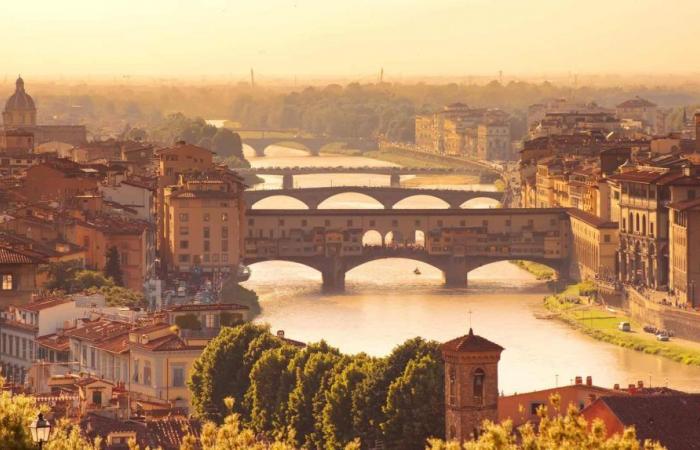Firenzedeclared UNESCO World Heritage Site in 1982, is one of the epicenters of European cultural, artistic and intellectual evolution during the Renaissance. Located in the heart of the Tuscanywas the center of a cultural movement that left an indelible mark on the history of art and thought. Firenze it has become a melting pot of revolutionary ideas and historical figures who have contributed significantly to the Italian cultural renaissance. The contribution of Medician influential family, financially supported and promoted talents such as Leonardo da Vinci, Michelangelo and many more. The city, with its historic buildings, churches and museums, remains a priceless treasure that continues to educate and inspire generations around the world.
Firenze played a major role in redefining artistic and architectural norms throughout Europe. His influence is manifested primarily through works that marked the transition from the medieval to the modern age. One of the main catalysts for this change was the revival of classical studies, culminating in the rediscovery of artistic-scientific techniques such as linear perspective, which led to the production of visually revolutionary works.
Several Florentine artists, whose impact is undeniable, include personalities such as Leonardo da Vinci e Michelangelo Buonarroti. Leonardo, with studies ranging from anatomy to botany, integrated a profound realism into his works; a clear example is the ‘Last dinner‘, which not only highlights the central perspective, but also captures intense human emotions through expressions and gestures. Michelangelo, on the other hand, used his profound knowledge of anatomy to infuse a dynamic energy into his sculptures, as demonstrated by the statue of ‘David‘, a representation of strength and humanity.
In parallel with the visual innovations, Firenze It was also a fertile breeding ground for literature and philosophy. The Italian language itself owed much to the creativity of Florentine writers. Dante Alighieriwith her ‘Divine Comedy‘, not only codified Italian but also offered an allegorical structure that explores human nature and its relationship with the divine. Following the path traced by Dante, other literary figures such as Petrarch e Boccaccio They contributed significantly to the progress of humanistic thought, which placed the human being and his abilities at the centre.
The philosophy of Renaissancewith protagonists such as Giordano Bruno e Pico della Mirandola, emphasized the dignity of man and his infinite search for knowledge through the Neoplatonic approach. These thinkers proposed the idea that man could, thanks to rationality and study, get closer to the divine image and better understand the cosmos. Pico della Mirandola, in particular, in his famous ‘Speech on the Dignity of Man‘, articulates a vision of man as the creator of his own destiny, capable of transforming himself through virtue and knowledge.
Through his multifaceted influences in different fields – from art to science, from literature to philosophy – Firenze not only shaped Italian culture, but also set new standards and ideals that pervaded and reshaped the European cultural landscape during and beyond Renaissance. Even the streets of Firenzedesigned to converge towards centers of power such as Piazza della Signoriareveal a careful urban planning study aimed at enhancing public buildings and facilitating the control of the masses.
The construction technique of the barrel and cross vaults used in buildings such as the Pazzi Chapelshows the transition from Gothic to Renaissance in construction method and aesthetics. These architectural elements not only define the appearance of Firenzebut also the era itself, showing how the city was a living laboratory where new technologies and artistic forms were experimented with that influenced the entire world. Firenzecornerstone of Renaissance, was the cradle of numerous works of art that not only shaped the artistic evolution of the era but continue to influence modern thought and global culture. Among the most significant contributions are the innovations in the use of perspective, the introduction of the chiaroscuro technique and the exploration of human realism.
The School of Athens Of Raffaello Sanziolocated in Raphael’s Rooms in the Vatican, it is emblematic for the masterful use of perspective, which set a new standard for spatial representation. The David Of Michelangelonot only represents incredible anatomical precision, but also symbolizes the ideal of human beauty and the symbol of political resistance to Firenze during that time. The birth of Venus Of Sandro Botticellidepicting the goddess Venus emerging from the sea, has become a Renaissance icon of beauty and nature, interpreted and rediscovered over and over again in different cultures and artistic contexts. These works not only represent the pinnacle of artistic ingenuity but have also served as matrices for countless discussions and studies in the fields of fine art, philosophy, and cultural theory, reinforcing the dialogue between different disciplines and cultures.
Florentine art has extended its influence far beyond Italy’s borders, touching artists, philosophers and thinkers throughout Europe and the world. The analysis of these works has allowed a parallel development of artistic and scholastic movements in different parts of the world, making Firenze a point of reference for cultural modernity. Impressionism: Attention to visual detail and light, key aspects of the art of Renaissancefound an echo in French Impressionism, where artists such as Claude Monet they completely reinvented the perception of light and color. Modernist movements: The influence of Renaissance it extended into 20th century modernism. Artists like Pablo Picasso they reinterpreted classic Renaissance compositions in a modern key, exploring new forms and distorted perspectives. Academic disciplines: Renaissance works are studied in university courses in art history, philosophy, and literature, highlighting the interdisciplinarity of Renaissance teaching and its continuing impact on contemporary education.
The city of Firenzerecognized as the site of World Heritage from theUNESCO since 1982, it has used an integrated management system for the conservation and enhancement of its artistic and architectural treasures. A crucial first step in the conservation process was the adoption of the “Historic Center Plan”, a strategic document that outlined precise urban planning policies to preserve the historical and cultural identity of the area. Among the measures adopted, we highlight: Limitation of vehicular traffic: In order to reduce air and noise pollution, which can be harmful to historic buildings, Firenze has implemented limited traffic zones (ZTL) in its most significant streets. Constant monitoring: Through the use of advanced technologies such as photogrammetry and GIS systems, authorities are able to monitor the condition of historic buildings.
Restrictions on modifying assets are strict to ensure that any renovation does not compromise the historical and aesthetic integrity of the monuments. Any intervention must be approved by the competent authorities. Educating and raising awareness among the local community and visitors about the importance of cultural heritage are key aspects of the Florentine conservation strategy. This approach is manifested through several initiatives. School students Firenze participate in educational programs that include guided tours, hands-on workshops and interactive lessons on the history and culture of the Renaissance. Firenze collaborates with cultural institutions and international non-governmental organizations through international partnerships for the exchange of knowledge and best practices in the conservation of cultural heritage. The promotion of culture also takes place through public events and exhibitions dedicated to Florentine history and the Renaissanceoften available for free or at a reduced rate.
By adopting these policies, Firenze It not only protects its historical and artistic heritage but also ensures that future generations can enjoy and learn from the treasures that have made the city a world cultural reference. Firenzewith its historic buildings, art-filled churches and vibrant piazzas, represents an invaluable treasure, a bridge between the human genius of the past and the cultural promise of the future. The maintenance and preservation of this legacy requires a concerted effort not only from the Italian government and local institutions, but also from the global community. The analysis of the contribution of Firenze al Renaissance allows us to reflect on the impact of city-states in the promotion of culture and the formation of more advanced civil societies. Investment in culture and art is seen as an essential driver of social and economic development. Firenzebeating heart of the Renaissanceremains an essential key to understanding the foundations of European and Western cultural identity, influencing countless aspects of contemporary social life.






